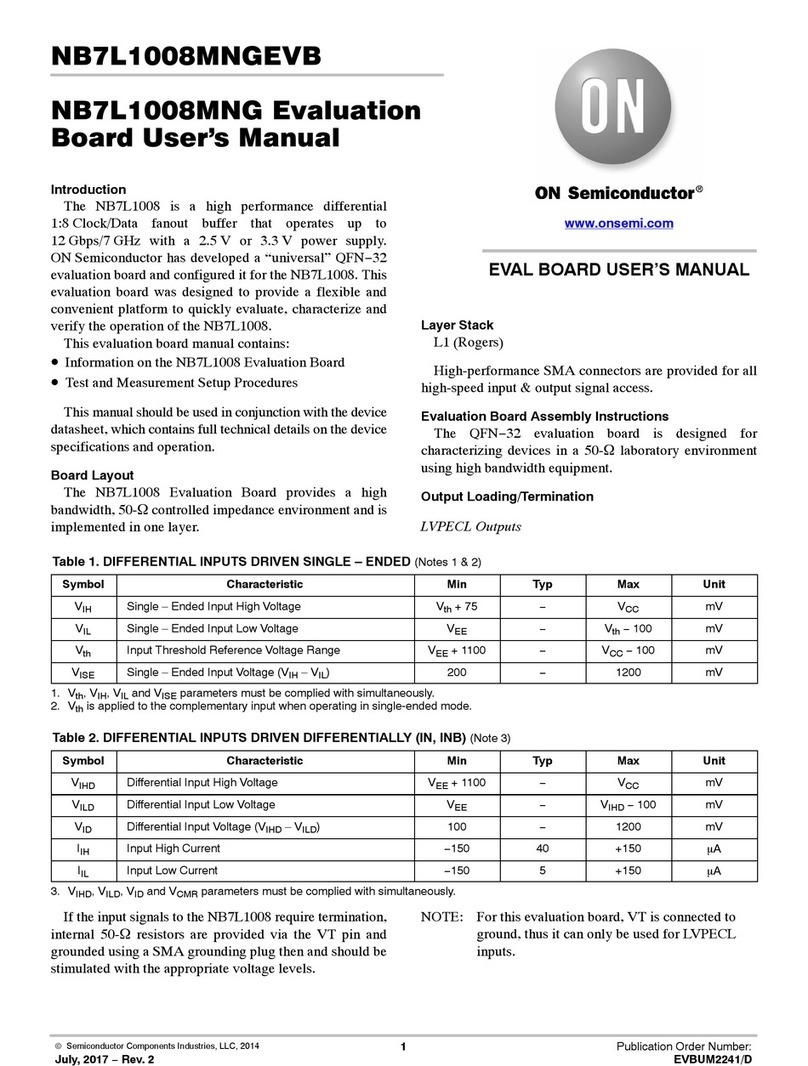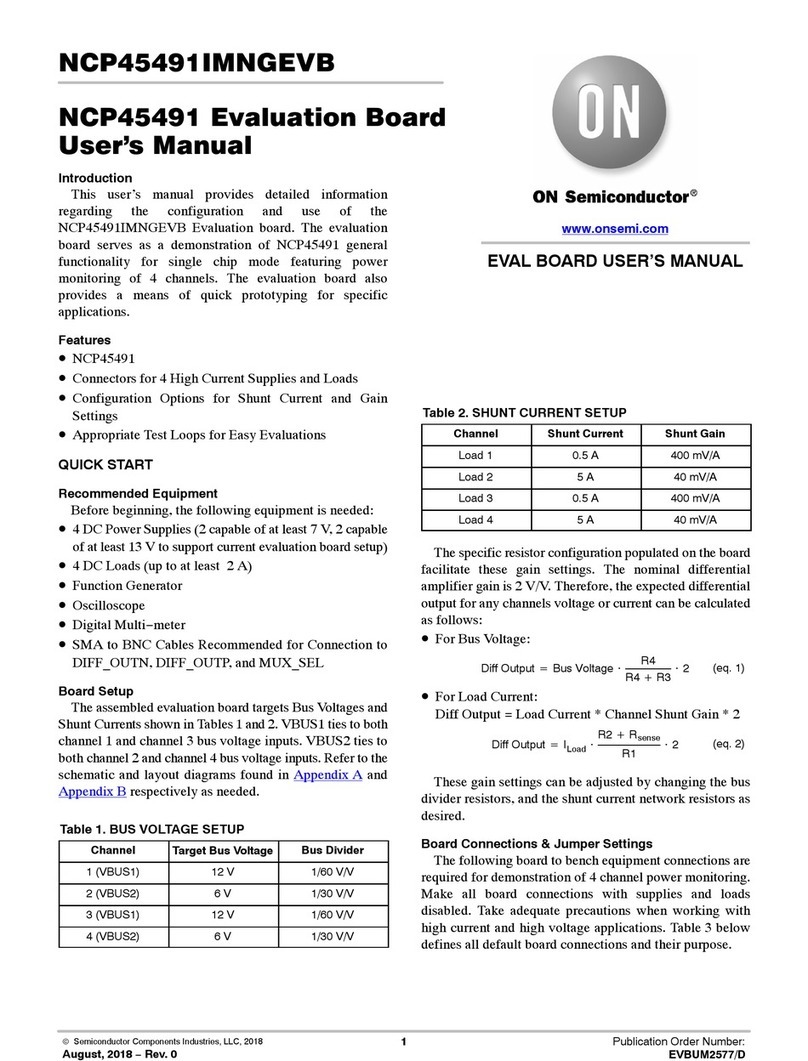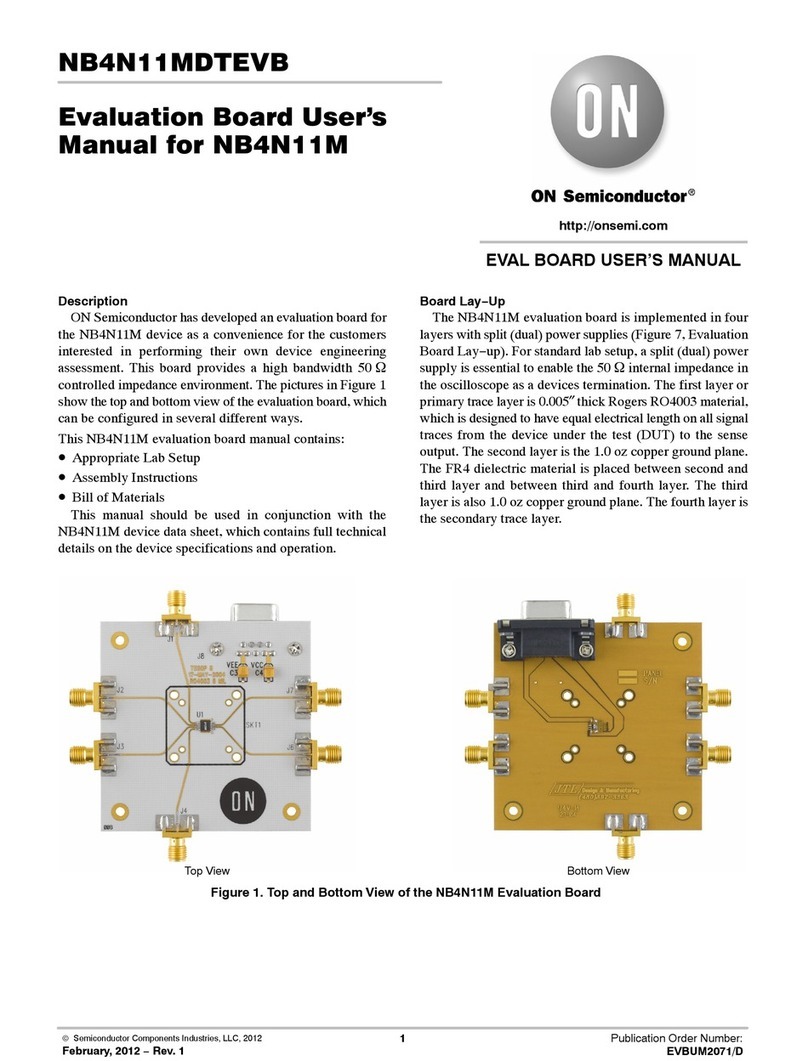
EVBUM2290/D
www.onsemi.com
2
Locations such as the secondary side medium voltage
(MV) transformers and overhead lines can deliver
tremendous amounts of energy and pose high risks.
For 230 VAC systems, only single-phase operation is
supported, i.e. with the power cable connected from neutral
to phase. Operation across two phases is not possible.
If damage is suspected, stop using the evaluation kit.
Contact ON Semiconductor to have it re-tested and
repaired.
Your sales representative or field application engineer can
also help you with other safety questions −do not hesitate to
contact them.
Primary-side Modifications and Measurements
From a safety point of view it is of course preferred to use
the evaluation kit with the mains-connected part unchanged.
However, testing customer-specific parts is often desired.
Preferably, the protective cover should only be removed for
the modification work (with the power cable unplugged!).
Before starting, ensure the board is safe. During operation
some primary-side capacitors are charged up to 350 VDC.
Although bleeding resistors bridge all high-voltage
capacitors, measuring the residual voltage on critical
capacitors remains a good habit.
Following modifications, most measurements can
proceed with the enclosure back in place and screwed-down.
If measurements on the primary side are truly needed and
the enclosure blocks access, a risk analysis must be
performed. Formal safety systems greatly help with this,
though this is outside the scope of this document; only a few
hints are noted below.
As an obvious safety precaution, shield as many
components as possible.
Limiting the energy available during an accident should
also be a priority.
Do not rely on the circuit breakers of the electrical
installation. Connecting the evaluation kit directly to the
mains, while fine for normal use, should never be done with
modified boards. Instead, use an AC power supply with low
trip current setting or an isolation transformer. Isolating the
board also protects measurement instruments. It may also be
required to avoid tripping residual current breakers.
Consider the required measurement method and
instruments carefully to avoid unsafe working and damage.
A good guide is available from Tektronix [23].
Never remove the protective earth of a measurement
instrument; while this allows floating measurements to
some extent, it exposes the operator to lethal voltages on the
instrument connectors.
Ensure the voltage rating of oscilloscope probes is
appropriate in order to protect the operator and the
oscilloscope. High-voltage probes are preferable to
general-purpose probes.
Consider slowly ramping up the AC voltage; gross defects
such as short-circuits or inverted diodes will be equally
obvious at lower voltages but will cause less damage.
Electrical shocks can cause cramps and unconsciousness.
Therefore, never work alone on energized low-voltage
systems; always ensure a knowledgeable colleague can raise
the alarm.
When the fuse fitted on the motherboard has blown,
replace it with a suitable type. A fast fuse of 1.6 A or less is
recommended3.
Evaluation Boards
The evaluation circuit is split up in a motherboard and
a daughterboard (Figure 1). Refer to [11, 14, 15] for the full
schematics.
Figure 1. Evaluation Boards: Motherboard and
Plugged-on Daughterboard
The motherboard contains the power supply, mains
coupling circuit (including the zero-crossing detection) and
a USB-to-teletype converter.
The daughterboard contains the modem itself, the power
amplifier, the receive and the transmit filter and the
protection circuit. Refer to the “Evaluation Kit Design”
section for a list of available daughterboards4.
Power Supply
An enclosed switching mode power supply (SMPS)
converts the AC voltage to a 12 V, 1 A DC voltage. An input
filter is required to comply with EME regulations.
Additionally, the impedance on the line must be sufficiently
high for the PLC frequencies. This precludes the use of
a capacitor directly between the phases. Instead, a fourth
order LC filter is used. For more information refer to the
application note “PLC modem power supplies”.
The input range of the power supply is 85–264 VAC and
120–370 VDC5. The coupling stage should work with any
power line with a voltage of less than 260 VAC (frequency
60 Hz or less) and 370 VDC.
Operation with a power line voltage above the given range
is not safe.
3The high current rating does not stem from the power supply,
which consumes 150mA at most, but from the PLC signal.
4If no daughterboard is available for the product or frequency
band you are interested in, contact your sales representative to
obtain tuned daughterboards.
5Consult the manufacturers datasheet for details: for the Mean
Well supplies refer to [8]; for the CUI supplies to [1].
Note that the IEC standard and IEC firmware requires a mains
zero crossing to synchronise transmission. Only the ON−PL110
firmware can operate without zero crossing, if it is configured to
do so (page 10).






























